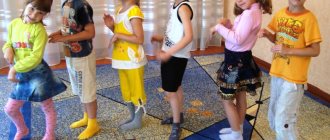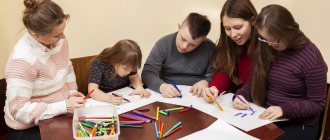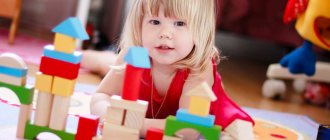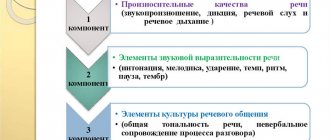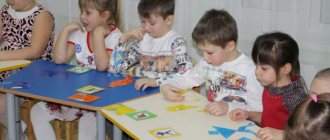Card index of didactic games on valeology card index on the topic
Card index of didactic games on valeology education.
Name it correctly
Goal: to consolidate knowledge about hygiene products, their purpose and correct use.
Material: ball
Description: the teacher throws the ball and names the object that needs to be told about (what the object is needed for).
———————————————————————————————————
When do we wear what?
Goal: developing the ability to distinguish items of clothing depending on the time of year.
Description: the teacher throws a ball and names an item of clothing. Children explain what time of year they wear these clothes and why.
——————————————————————————————————————
Who am I?
Goal: expanding the child’s knowledge about himself, his name, his surname, age.
Equipment: mirror;
Description: - Tell us what you know about yourself (name, age, height, hair color and length, eye color, date of birth, girl or boy).
Tell me who you are like: mom or dad.
Do you have signs that are present in any animal or bird?
————————————————————————————————————
Name the athlete
Goal: to develop a respectful attitude towards athletes, to develop the ability to distinguish and name sports.
Material: pictures of athletes.
Goal: to develop a respectful attitude towards athletes, to develop the ability to distinguish and name sports.
Description: Children play in pairs. One takes a picture of an athlete and shows the given sport with a movement, the other guesses. Then the players change places.
———————————————————————————
What first - what then (daily routine)
Goal: to reinforce the idea that following a proper daily routine is good for health.
Material: plot pictures depicting actions characteristic of a certain period of the day.
Description: invite players to arrange the pictures in the correct sequence and explain their choice.
————————————————————————————————————
Sun, air and water are our faithful friends
Goal: to form an idea about the means and types of hardening (water, air, solar), their importance for health.
Material: story pictures.
Description: children look at the pictures and determine what health benefits the sun, air and water bring. The one who names the most useful properties wins.
—————————————————————————————————————
How should you take care of yourself?
Goal: developing skills to monitor compliance with personal hygiene rules.
Equipment: chips, cards with questions.
The presenter spins the top, which determines the card with the question. For the correct answer, the child receives a chip. The one with the most chips wins.
Questions
1. Name the items you need for washing (soap, towel).
2. Name the items you will need to take a shower (shampoo, soap, shower gel).
3. How often should you wash? (Every day).
4. How often should you brush your teeth? (In the morning and in the evening).
5. How often should you cut your nails? (At least once every 10 days).
6. How often should you wash your ears? (Every day).
7. How often should you change your underwear? (Every day).
———————————————————————————————
Show me and I'll guess
Goal: to develop a respectful attitude towards athletes, to develop the ability to distinguish and name sports.
Description: one subgroup of children, using specific movements, shows (makes a guess) what kind of sport they are involved in. Another subgroup guesses who was depicted (skier, swimmer, hockey player, gymnast, etc.).
———————————————————————————————————
What do we know about things?
Goal: to expand children’s understanding of the rules of safe behavior at home; develop attention and memory; foster a sense of cooperation.
Material: cards depicting a cut, burn, hand bruise and fire; pictures depicting various household items.
Description: The teacher (child) is the leader. He picks up a picture of an object one by one. Participants must guess what kind of injury could result from improper handling of this item. When answering, the child must explain why this or that object is dangerous and tell the rules for handling it.
——————————————————————————————————-
ABC of mood
Goal: strengthening the ability to determine a person’s emotional state by facial expressions and gestures.
Material: cards conveying different moods of several characters (joy, anger, fear, dissatisfaction, etc.).
Description: players are asked to complete tasks such as “define the mood”, “choose a hero” (with a certain mood), “tell. what happened to him” (explain the reason for his emotional state).
—————————————————————————
So that your eyes don't hurt
Goal: to consolidate knowledge about the organ of vision, about the necessary rules that will help preserve the eyes and vision.
Material: Pictures depicting certain activities that should be avoided to preserve your vision.
Description: children choose pictures depicting the necessary rules that must be followed to preserve their vision.
————————————————————————-
What foods keep your teeth healthy?
Goal: developing the ability to identify foods that are healthy and harmful to dental health.
Material: dummies of food, vegetables, fruits, plates.
Description: Children are invited to place on plates foods that are good for dental health and those that are harmful.
—————————————————————————-
If you are sick
Goal: developing the desire to take care of your health and avoid situations that are harmful to your health.
Material: pictures depicting certain actions.
Description: children choose from the pictures those that depict how to behave when sick.
————————————————————————————
To avoid getting sick...
Goal: developing the ability to avoid situations that are harmful to health.
Material: story pictures.
Description: children choose pictures depicting actions that allow them to protect their bodies from diseases.
———————————————————————————————
Message from the monkey
Goal: forming an idea of your body; consolidation of the knowledge that objects can be recognized by appearance, smell, taste, touch; practice identifying fruits by taste and smell.
Material: parcel with vegetables, fruits
Description: inform the children that a package has arrived from the monkey; it may contain either a vegetable or a fruit.
Invites children to find out what kind of vegetable or fruit is in the package. One child is asked to put his hand into the parcel and determine its contents by touch. Another is asked to try a piece and identify it by taste, a third is asked to identify it by smell, and for a fourth, the teacher describes this vegetable (fruit). The one who guesses correctly wins.
——————————————————————————————
Guess by sound
Goal: to form an idea of a person’s assistant (ears), to develop skills in exploring objects using the appropriate sense organ.
Material: musical instruments.
Progress of the game: the teacher behind the screen makes sounds on various musical instruments, the children guess them. — What helped you hear different sounds?
——————————————————————————————
We see, we hear, we feel
Goal: to consolidate the idea of the sense organs.
Material: story pictures.
Description: choose from the proposed pictures first those sense organs that allow us to breathe, then see and feel.
———————————————————————————————
Identify by smell
Goal: to form an idea of the functions of the olfactory organ.
Material: fruits, plates with jam, cotton pads with perfume aroma.
Description: ask to identify the characteristic smell with your eyes closed.
————————————————————————————————-
Who's doing what?
Goal: strengthening children’s understanding of the functions of human internal organs, developing logical thinking.
Description: propose to distribute the words into groups (which organ of our body they relate to): cold, bitter, loud, fresh, sour, hot, dark, etc.
——————————————————————————————————
Braggart
Goal: developing a caring attitude towards your body, developing imagination and speech.
Description: offer to talk about any organ or part of your body. For example: “My hands are small, the skin on them is smooth, soft, they help me do...”
——————————————————————————————————
Correct pictures (how to take care of your heart)
Goal: fostering a caring attitude towards your body, learning the rules that help keep your heart healthy.
Material: pictures depicting certain actions, red and green chips.
Description: invite children to put a green chip on pictures depicting actions that help keep the heart healthy, and vice versa - a red one.
———————————————————————————————————
Catch, throw, name hygiene items
Goal: to consolidate children’s knowledge about hygiene items.
Material: ball.
Description: children stand in a circle, the teacher is in the center. Take turns throwing the ball to the children. Children name hygiene items that they use and know.
———————————————————————————————-
Consultation for educators on the topic “Problems of educating valeological culture in preschool children”
The problem of educating valeological culture in preschoolers is one of the most pressing today. The relevance is explained by the decline in the health of modern children. This refers to their mental and physical health. This is evidenced by statistics: today no more than 14% of children are born physiologically mature, i.e. Most people are not ready for a physiologically full life immediately after birth. 25-35% of children entering grade 1 have physical disabilities or chronic diseases. It has been established that 40% of adult diseases have their origins in preschool age. The reasons for this are related to the socio-economic processes taking place in Russia. But the main reason is the cultural crisis of society and, as a consequence, the low level of knowledge of parents about the value of their health and the health of their children.
During the preschool period, the formation of the most important qualities of the human personality takes place, in particular, the basic skills for developing a healthy lifestyle are laid. We need to help children: be conscious of health and life; acquire knowledge about health and acquire the skills to protect, maintain and preserve it; independently and effectively solve problems related to a healthy lifestyle, safe behavior, provision of basic medical and psychological self-help and assistance.
It is important to teach your child to understand how valuable health is for a person and how important it is to strive for a healthy lifestyle. A healthy lifestyle is not just the sum of acquired knowledge, but a lifestyle, adequate behavior in various situations.
The outstanding teacher Janusz Korczak wrote: “It seems to adults that children do not care about their health: if you didn’t look after them, they would all fall out of windows, drown, get hit by cars, damage their eyes, break their legs and get sick.” inflammation of the brain and pneumonia - and I don’t know what other diseases. No. Children, just like adults, want to be healthy and strong, but children do not know what to do for this. Let us explain to them, and they will be careful.”
The need to cultivate a valeological culture is emphasized by studies confirming that a person’s health depends only 7-8% on the success of healthcare and more than 60% on his lifestyle.
For the first time, the largest Russian microbiologist, doctor Ilya Ilyich Mechnikov, spoke about the need to instill valeological culture in humans and its essence. He believed: the most important thing is to teach a person the correct, unmistakable choice in any situation only that which is useful, that promotes health and the rejection of everything harmful.
The formation of human valeological culture is determined primarily by the process of education, pedagogical interaction between an adult and a child, and a wide range of pedagogical means and techniques.
The problem of preserving and strengthening human health is partially revealed by such authors as V. G. Alyamovskaya, Yu. F. Zmanovsky, S. A. Kozlova, O. L. Knyazeva, L. N. Lagutkina, T. L. Rozanova, R. B. Sterkina, L. G. Tatarnikova and others.
In-depth work on the education of valeological culture in children using various forms and methods of improving children's health (experimentation, music therapy, relaxation exercises, solving everyday situations, etc.) has been going on for six years.
Some experience has been accumulated. First, the tasks of educating the valeological culture of preschoolers were specified:
- formation of a conscious attitude towards health as a leading value and motivation for a healthy lifestyle;
- accumulation of knowledge about health, acquisition of skills that support, strengthen and preserve health;
- the formation of a child’s valeological competence as a readiness to independently solve the problems of a healthy lifestyle and safe behavior in unforeseen situations and the provision of basic medical and psychological assistance.
In order to determine the level of valeological culture and determine the content, forms and methods of work, preliminary work was carried out: a survey among parents, observation of children’s behavior, conversations with children. As a result, it was revealed that children’s careless attitude towards their health is often explained by their lack of necessary knowledge. Children often lack interest in recreational activities. This is due to the fact that adults themselves rarely adhere to these rules in everyday life, and children see this well. In addition, following the necessary rules of a healthy lifestyle requires significant volitional efforts from a person, which is extremely difficult for a preschool child who has an insufficiently formed emotional-volitional sphere. Parents try to instill in their children basic hygienic skills and monitor the maintenance of health, but to ensure continuity in the formation of healthy lifestyle habits in preschoolers and primary schoolchildren, the joint work of teachers and parents is necessary.
The formation of valeological culture in preschoolers is a holistic process. It requires mastering a certain amount of knowledge on valeology and studying various techniques for working with children, as well as promoting valeology knowledge among parents.
We have identified the therapeutic mechanisms of valeological education:
- helps improve health;
- promotes the development and strengthening of the bone, muscle, cardiovascular, respiratory, and nervous systems;
- increases performance;
- has positive results on the inculcation of cultural and hygienic skills; helps maintain and strengthen posture;
- Helps to acquire organ care skills.
In the content of work on valeological education, educational activities with children occupy a significant place.
The program of health-improving and pedagogical classes for preschoolers consists of 6 blocks, each block corresponds to a graphic image.
Blocks of the work system for creating a healthy lifestyle culture among preschoolers
Know your body:
In classes in this block, children receive a basic understanding of the structure and functions of some organs of their body (heart, brain, bones, etc.), in addition, the influence of various forms of behavior on the work of these organs is considered.
Follow the rules of hygiene:
Particular attention is paid to the formation of practical skills and habits of compliance with hygiene rules.
Say NO to bad habits:
Psychological techniques are widely used in work on this block; In parallel with the prevention of bad habits, there is the consolidation of good habits.
Do physical exercise:
Together with children, the importance of movement for health, the benefits of outdoor games and sports are revealed.
Follow your daily routine:
The work is aimed at developing independence in performing basic routine tasks. This block also includes knowledge about proper nutrition, since eating is one of the routine moments in kindergarten.
Monitor your mood sensor:
Children gain an understanding of mood, emotions and feelings, and their impact on health. The main goal of the classes is to increase psycho-emotional stability
Of course, knowledge alone is not enough to form a valeology culture in children; we will solve the problems of valeology education in all types of children's activities.
One of the conditions for effective valeological education of preschoolers is constant self-improvement; the subjective position of the teacher, which allows you to constantly develop and enrich your professional competence through: introspection and self-determination in the field of educating the valeological culture of preschoolers; self-enrichment and enrichment of the already mastered theoretical and methodological foundations of valeology, as well as practical ways of their implementation in professional activities; expanding professional horizons and opportunities for realizing creative potential during work.
One of the mandatory conditions for raising a child’s valeological culture is the valeological culture of the family. We will develop and enrich it through the following forms of interaction with parents: open days; parent meetings, workshops, consultations; pedagogical conversations with parents (individual, group on problems); showing classes for parents; parent club "Health"; joint activities for children and parents; round tables with the participation of specialists (nurse, educational psychologist, physical instructor); days of family hobbies “I will teach my children what I can do”; "Inquiry Office".
The family work system included the following components:
1. Familiarization of parents with the results of diagnostics of the child’s psychomotor development, the health status of the children in the group, determination of tasks for the health of children, drawing up a plan of health measures for the entire group and individual health plans for frequently ill children.
2. Targeted health education work promoting general hygienic knowledge and the need to correct the child’s lifestyle, daily routine, hardening, organizing a balanced diet, optimal air and temperature conditions in the apartment.
3. Familiarization of parents with therapeutic measures carried out in a preschool educational institution: herbal medicine (rinsing the mouth after eating); aerophytotherapy using essential oils, phytoionizer - 2 courses per year of 15 sessions; the use of garlic phytoncides for the prevention of acute respiratory diseases 2 times a year and during epidemic situations; taking vitamin herbal cocktails (rosehip decoction - 2 times a year; infusion of St. John's wort with honey - 1 time a year for frequently ill children), tinctures of immunocorrector plants (Eleutherococcus, - radiola) - 2 times a year for 3 weeks for frequently ill children ; General Ural Federal District - 2 courses per year of 15 sessions; taking multivitamins - 2 times a year, yeast drink - 10 days 1-2 times a year for frequently ill children; lubricating the tonsils with inhalipt and rosehip oil; instillation of herbal infusions and rosehip oil into the nose; the use of thymogen for the prevention of acute respiratory diseases during the adaptation period of some frequently ill children and for therapeutic purposes in the detection of acute respiratory diseases; biocorrection (according to indications); general and therapeutic massage.
4. Familiarization of parents with the content of educational work, pedagogical activities aimed at training the adaptive mechanisms of the child’s body: three walks a day, ensuring optimal physical activity during walks, morning exercises, classes, gymnastics after a nap, in independent motor activity; inclusion in physical education classes of cyclic movements, exercises for the formation of posture, prevention of flat feet, development of sensory skills, cognitive interests of children, elements of breathing exercises, self-massage: differentiated content of exercises taking into account the level of physical readiness and gender of children.
5. Teaching parents specific techniques for improving the health of children (massage techniques, methods of rinsing the mucous membrane of the nose and throat, applying a compress, brewing herbs, hardening with air and water, playing outdoors, morning exercises).
6. Involving parents in basic diagnostics (identifying the child’s performance; individual seasonal sleep duration, etc.).
7. Consultations with a psychologist and teachers aimed at developing in parents the ability to understand the child, establish contacts with him, changing the style of communication (moving to the position of a partner or a ward), organize interesting activities that develop the environment at home, revealing the influence of types of family upbringing on the child’s personality.
8. “Physical education” education of parents through keeping an oral journal (speeches by parents with experience in family education, teachers, psychologists), organizing seminars, discussions, business games at parent meetings and consultations; trainings for different types of families; listening to tape recordings of conversations with children about how their families maintain a healthy lifestyle. Carrying out joint physical education activities, classes, KVN, and holidays with parents; At the same time, participants get to know each other’s capabilities, perform exercises that involve tactile-muscular rapprochement, as well as exercises with exercise machines and in sports complexes. Parents are convinced of the close connection between the physical and mental development of a preschooler and the need to create special conditions at home for physical activity. Some modernization of Parent Corners also encourages parents. Of great interest are the group’s health passport and the screen of recreational activities (indicating their content in the form of symbols and, as a result, the results of attendance). A parent’s corner can become a center for the exchange of information between all participants in educational and health work if its content changes seasonally, answers to questions of interest to parents are included (based on the results of the survey - “Parents Ask”), sections with specific recommendations are opened: “Let’s start with ourselves” (about diagnosing health conditions), “I want mom and dad to be healthy” (recommendations for the health of adults), “Dad and mom, work out with me,” “Our health diary for the week,” “Joint atelier” (clothes by season ), “Visiting Aibolit” (“Help yourself”, “Biorhythms are serious”, “New in children’s nutrition”, “Colds are receding”), “Visiting Neboleyka” (based on materials from the magazine “Health” ), “Physical exercises for the development of the child’s psyche, analytical systems”, “Our toy library”; advice from a psychologist (“Physical education and music”, “Stress”, “School of mental health”); “Reports from the vacation spot”, “ABC for parents” (where individual recommendations are given in alphabetical order), a library for parents.
9. Visits by parents to a preschool educational institution in order to ensure the successful adaptation of children.
10. Activating the interest of parents by performing unexpected tasks (for example, grandparents, mothers and fathers remember their favorite games and write them down in a group album-album, write down proverbs, poems and sayings about a healthy lifestyle, etc.).
We managed to make parents our helpers and allies in our work to educate children about valeological culture. They help in creating a health-promoting environment in the group: visibility, sports equipment, and provide all possible assistance in carrying out various events.
An important condition for the upbringing and development of a child is the creation of a valeologically developing environment.
In our kindergarten there are great opportunities for educating children about valeological culture: a physical education room, a music room, and a medical room. office, dry pool, “Health” discs, various devices for self-massage.
The group has created physical education corners equipped with the attributes necessary for general developmental exercises, corrective, invigorating gymnastics, and posture correction. Health zones have been designed with educational games, manuals, photographic materials (created by children and teachers, as well as parents), a library, mobile folders, and plants that benefit people. An area of peace and quiet has been created, allowing the child to rest and relax, to be alone with himself.
A valeological developmental environment is created with the goal of teaching children to navigate it, to be able to use it in solving problems of strengthening, preserving and maintaining health. The nature of interaction with a child in the valeological environment of a kindergarten is defined as pedagogical support: assistance in the active use of the environment in solving designated problems.
We consider dialogue to be an important condition for pedagogical support: cooperation with the child in the form of conversations, joint solving of problems and situations of choosing environmental objects and actions with them, activating the independent choice of environmental objects with which the child wants to interact.
The process of educating valeological culture is also ensured by the activity and independence of the child himself, therefore we support this activity, create conditions for the emergence of interest in solving problems of valeological content and the success of this solution by ensuring the integration of valeological education with other types of activities. We carry out our work in close collaboration with specialists (nurse, educational psychologist, additional education teachers: music director, physical education instructor).
A child’s acquisition of the experience of a healthy lifestyle is carried out through coordinated activities with parents, organization of the children’s daily routine and nutrition, and the environment with which children interact.
Thus, step by step, the child accumulates experience in preserving and maintaining health, masters the appropriate competence, and strives to demonstrate it.
Thus, the education of valeological culture in preschoolers is ensured through the interaction of the following pedagogical conditions:
- teacher competence in solving problems related to the education of valeological culture in preschool children;
- valeological culture of parents;
- integration of the tasks of educating valeological culture into the holistic pedagogical process;
- creation of a valeologically developing environment in a preschool educational institution, group and pedagogical support for the child in it;
- taking into account the age characteristics of children and implementing an individual approach to each child during the development of valeology culture.
The effectiveness of the work on cultivating valeological culture is evidenced by the positive dynamics in the valeological development of preschool children: ideas about their body and organism have been formed, children’s interest in improving their own body has increased, children have acquired the ability to determine their condition and sensations, skills have been formed in leading a healthy lifestyle, and the level of incidence by 0.8%.
The positive dynamics in the level of development of valeological culture among preschoolers amounted to 25% (middle group) in the 2007/08 academic year compared to the 2006/07 academic year, and in the current year compared to the last academic year - 10% (senior group).
Being healthy is the natural desire of every person. The foundations of physical and mental health are laid in childhood. We believe that it is important to form a valeological culture in a person from childhood. We must teach a child to love himself, people, and life. Only a person living in harmony with himself and with the world will be truly healthy.
Bibliography
- Derkunskaya, V. A. Valeological education of preschool children // Preschool pedagogy. - 2004. - No. 4 (19) /July-August/. - With. 11-14.
- Derkunskaya, V. A. What modern preschoolers think about health // Preschool pedagogy. - 2004. - No. 4 (19) /July-August/. - With. 6-8.
- Childhood: a program for the development and education of children in kindergarten / V. I. Loginova, T. I. Babaeva, N. A. Notkina and others; edited by T. I. Babaeva, Z. A. Mikhailova, L. M. Gurovich. — Ed. 2nd, revised - St. Petersburg. : Aksident, 1996. - 244 p.
- Zaytsev N.K., Kolbanov V.V. Strategy for understanding a healthy lifestyle among teachers//Valeology: Diagnostics, means and practice of ensuring health. Issue 3. Vladivostok: Dalnauka, 1996. p. 148-153.
- Pavlova, A. M. Health-saving system of a preschool educational institution: program models, recommendations, lesson development / author-comp. M. A. Pavlova, M. V. Lysogorskaya, Ph.D. psychol. Sci. - Volgograd: Teacher, 2009. - 186 p.
- Copyright 2009 c Women's online magazine “I am a star” - https://www.yazvezdochka.ru/zdorove/zdorove_doshkolnikov/.
Consultation for teachers on the topic: “Application of valeological principles in a preschool institution”
Consultation for teachers
on the topic: “Application of valeological principles in a preschool institution”
Prepared by the teacher
MBDOU kindergarten No. 33 “Firefly”
At the present stage, the problem of preventing children's health is one of the most pressing. Preschool institutions, fulfilling the social order, bear full responsibility for the upbringing of a person - a physically, morally and spiritually healthy person, a comprehensively and harmoniously developed person. That is why the affirmation of a healthy lifestyle of the younger generation should be considered today in the practice of kindergartens, as one of the priority areas of humanization of education, since the subsequent real life depends on how successfully one can form and consolidate healthy lifestyle skills at an early age. lifestyle and human health.
In preschool childhood, as a result of targeted pedagogical influence, health, vital activity and other qualities necessary for the comprehensive, harmonious development of the individual are formed. Properly organized educational work in preschool educational institutions often, to a greater extent than medical and hygienic measures, ensures good health and prevents the development of child diseases at the earliest stages. The success of raising a healthy child in kindergarten is ensured by the following mandatory conditions:
— the teacher’s readiness to implement valeology education for children;
— personality-oriented interaction between an adult and a child in the process of mastering the program;
- active participation of parents in the educational process;
- establishment of connections by the teacher with the school, public organizations, and additional education institutions.
Valeology is the science of a healthy lifestyle, preservation, formation of health, and management of it. In relation to preschool education, valeology aims to teach children the basic rules and norms of promoting health and instilling healthy lifestyle skills: active work, rational rest, hardening, physical education and self-development, balanced nutrition, personal hygiene, timely consultation with a doctor.
Valueological education of preschool children is based on the following principles:
- a systematic approach - that is, education is not carried out in isolation, but in connection with the moral, aesthetic, psychophysical formation of the child’s level of development. It is impossible to keep the body healthy if you do not improve the emotional-volitional sphere, if you do not work with the soul and morality. Successful solution of the problems of valeology education is possible only by combining the efforts of the kindergarten and parents;
- activity approach - valeological culture is mastered by children in the process of joint activities with adults.
The fundamental principle in our work is considered to be the “Do no harm” principle, which provides for the use of only safe healing techniques.
The principle of humanism is important; the intrinsic value of the child’s personality is recognized. The moral guidelines of education are universal human values.
The principle of altruism, in turn, provides for the need to share the mastered values of valeological culture: “If you learn it yourself, teach it to a friend”
And finally, the principle of measure. Anything in moderation is good for health.
To help children remember information better, you need to include several memorization techniques in the lesson - through sounds, smells, taste, movements, imagination. For example, through physical education minutes and gymnastics for the eyes, stories and fairy tales on moral and aesthetic themes, etc. In this case, the maximum number of senses is included.
No matter how weak a person’s abilities may be, he can improve his memory through a variety of memorization techniques. One of these memorization techniques. One of these techniques is called mnemonic. Making collages and mnemonic tables is a creative work. They can be made varied and interesting.
Thus, collages are teaching aids that perform the following tasks:
1) Development of visual memory,
2) The ability to speak, tell stories,
3) A learning task, because they contain different information.
Mnemonic tables are diagrams, structures in which various information can be stored.
Issues of protecting children's health and creating a culture of healthy lifestyles should become one of the areas of activity of our kindergarten.
For the full development and health of children in kindergarten, all conditions must be created: an environmental room, a music room, a gym, a medical staff office, a treatment room, an isolation ward for sick children, aroma lamps, health paths; work as a speech therapist and psychologist. It is impossible to develop a child without creating appropriate conditions for this. Therefore, one of the important stages in instilling the basics of a healthy lifestyle in children is the creation of a subject-based developmental environment in the group. First of all, children need clarity, a valeology corner, where the rules of a healthy lifestyle, plans for caring for teeth, hair, skin, etc. can be presented in various forms. Through diagrams and drawings, models of the human body, children have the opportunity to get acquainted with the human body. Also offer children morning exercises and sports exercises to practice at home. At the center of the role-playing game, children should be presented with all the attributes for games in which the child can reinforce the rules of hygiene and interaction with peers in problematic and everyday situations.

